Resources
Q Report Resources
Explore Q Report's Content Centre for expert advice on jewellery insurance. You can also read e-guides and blogs, watch videos and more.
Explore Q Report's Content Centre for expert advice on jewellery insurance. You can also read e-guides and blogs, watch videos and more.
So you’re interested in learning about luxury watches? Welcome to the club.
Buying a luxury watch requires some know-how. It’s a big purchase, and much of the satisfaction comes in learning about these incredible little machines.
From the precision of a chronometer to the complications on the dial, there’s so much to learn about luxury timepieces. In this Ultimate Guide to Luxury Watches, you’ll discover the answers to your questions and more.
Ready to learn about the wonderful world of luxury watches?






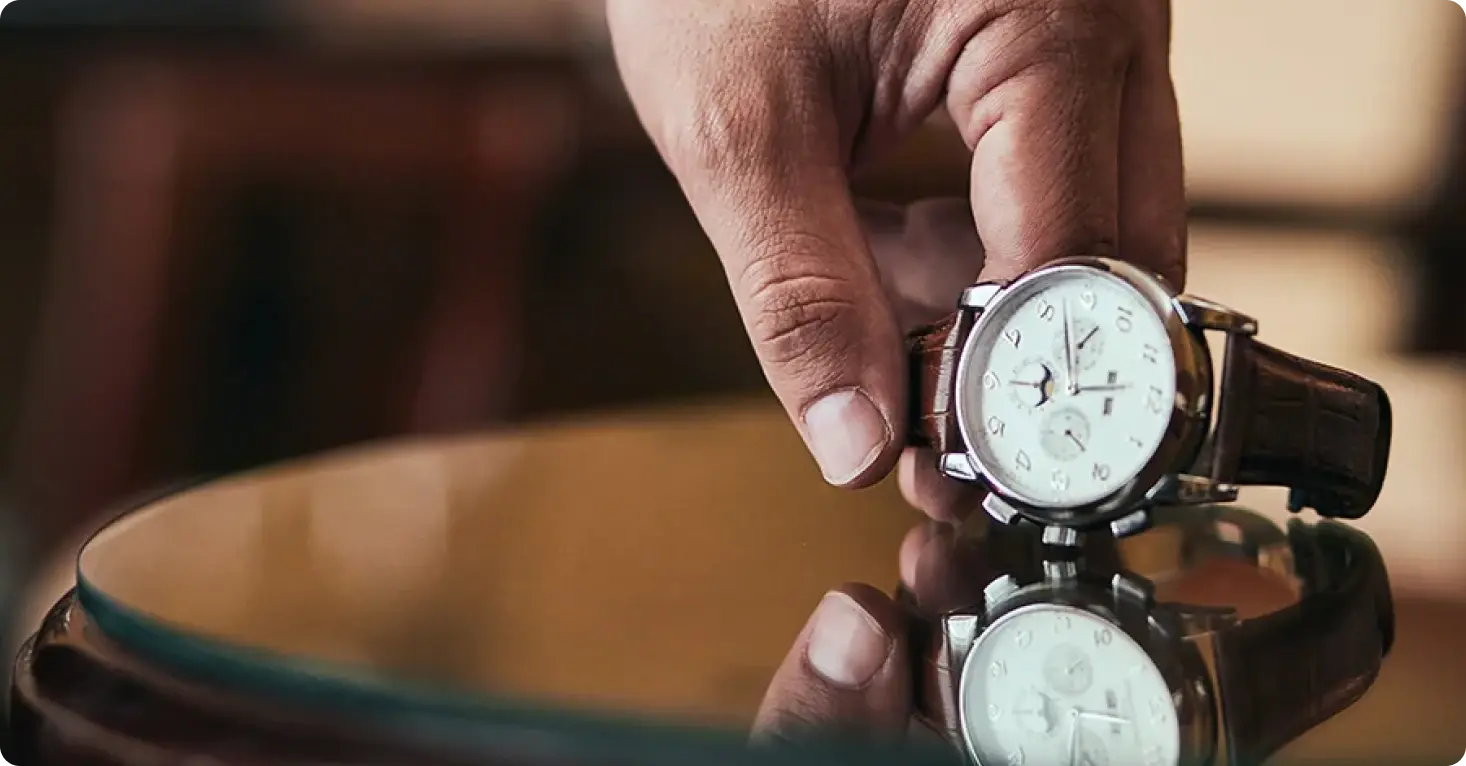
In this chapter, we’ll look at the origins of today’s luxury timepieces. You may be surprised to learn that men haven’t been wearing wristwatches for long! We’ll also explore the components that work together to create today’s finest watches.
In the age of smartphones and fit bits, everyone knows what time it is. But that hasn’t always been the case. In fact, the modern wristwatch as we know it has only been around for about a century. To help us understand how we got here, let’s take a brief walk through wristwatch history, starting in the late nineteenth century. At that time, no self-respecting gentleman would have worn a watch on his wrist. Real men carried pocket watches.
Women wore watches on their wrists. They were called “wristlets,” and most people considered them to be a passing jewellery fad. In fact, watches fell so squarely in the feminine domain that many a gentleman proclaimed he would “would sooner wear a skirt as wear a wristwatch.” Taking cues from their customers, watch manufacturers continued to produce pocket watches until war arrived and changed everything.
In the late nineteenth century, military men began to express frustration with the clumsy nature of pocket watches. These soldiers depended on their timepieces for executing carefully devised strategies, yet their watches slipped out of their pockets during combat and required too much attention.
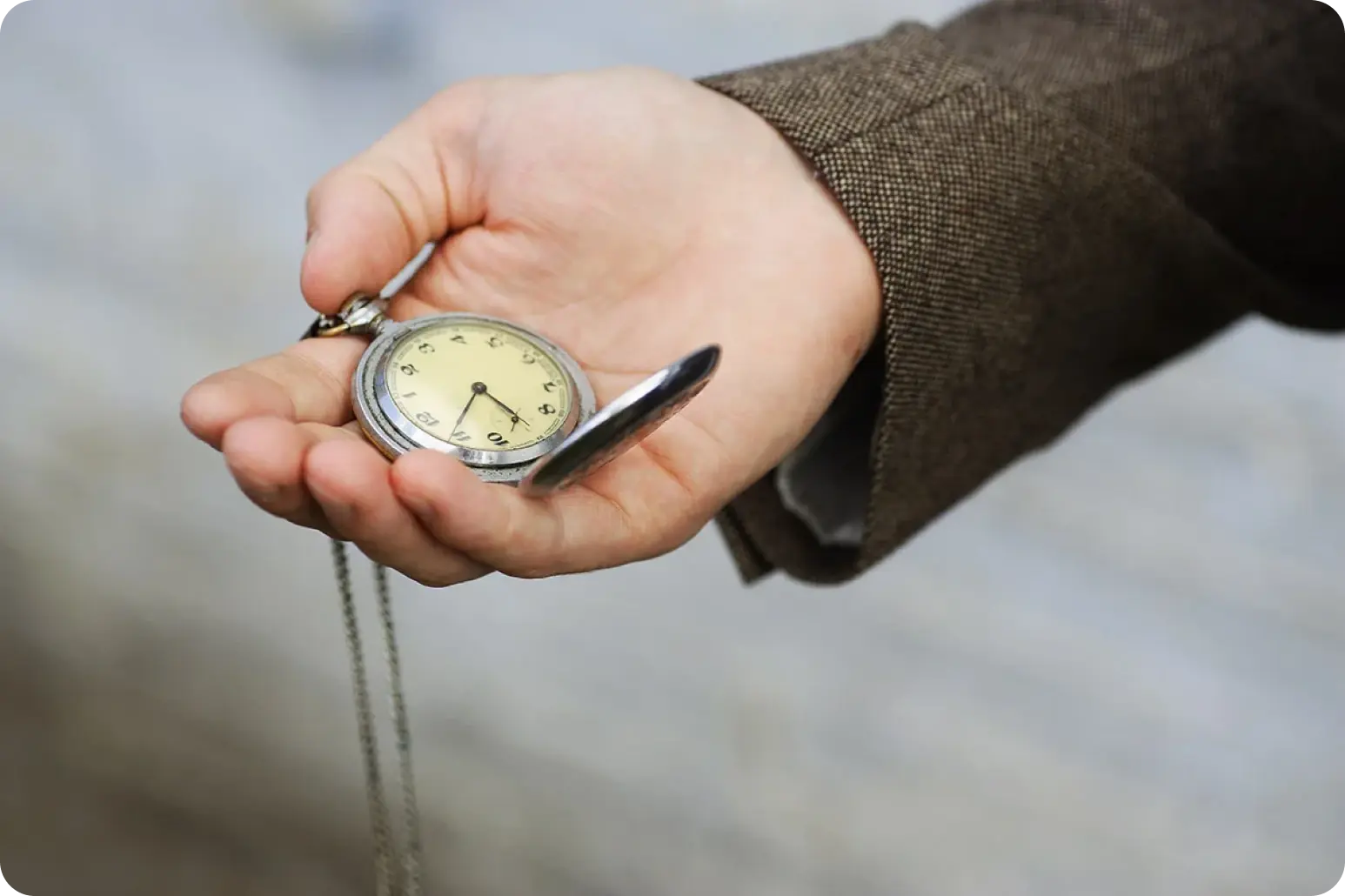
To solve these problems, soldiers began creating leather straps to cup their watches to their wrists so they could keep their hands free during battle. Sometime in the 1880s, the German Imperial Navy began issuing such devices to their men, helping them to synchronise their naval attacks.
British military leaders realised that synchronised attacks were vital to winning battles. During the Anglo-Boer War in South Africa (1899-1902), British soldiers cannibalised their timepieces to create makeshift wristwatches they could wear during combat. Upon their return home, these soldiers’ testimonials were often used by watch shops who were seeing new opportunities: wristwatches for men.
But until World War I, wristwatches for men remained outside the mainstream. Allied troops had a range of wristwatches to choose from, from small silver pocket watch cases fitted to leather straps to radium-illuminated porcelain dials protected by shrapnel guards. By this time, watches were considered a standard wartime accessory, every bit as important as binoculars or compasses.
Watch manufacturers scrambled to keep up with the wartime demand. One company that capitalised on the burgeoning market was Wilsdorf & Davis, Ltd. which became known as Rolex in 1915.
When the heroes of World War I returned home wearing their “trench watches,” public perception changed dramatically. Nothing was feminine about these soldiers and their wristwatches.
While the gentleman’s wristwatch was born out of necessity, it has become a symbol of elegance, class and style. Over the past century, men’s luxury watches have allowed us to wear some of the best engineering and design in the world right on our wrists. Why not wear a luxury watch as a tribute to human ingenuity?
A wristwatch seems like a simple contraption. It sits idly on your arm, ready to offer the time. But a luxury watch is anything but simple, and that’s what makes it so fascinating.
In this section, we’ll learn about the components of a watch and their functions.
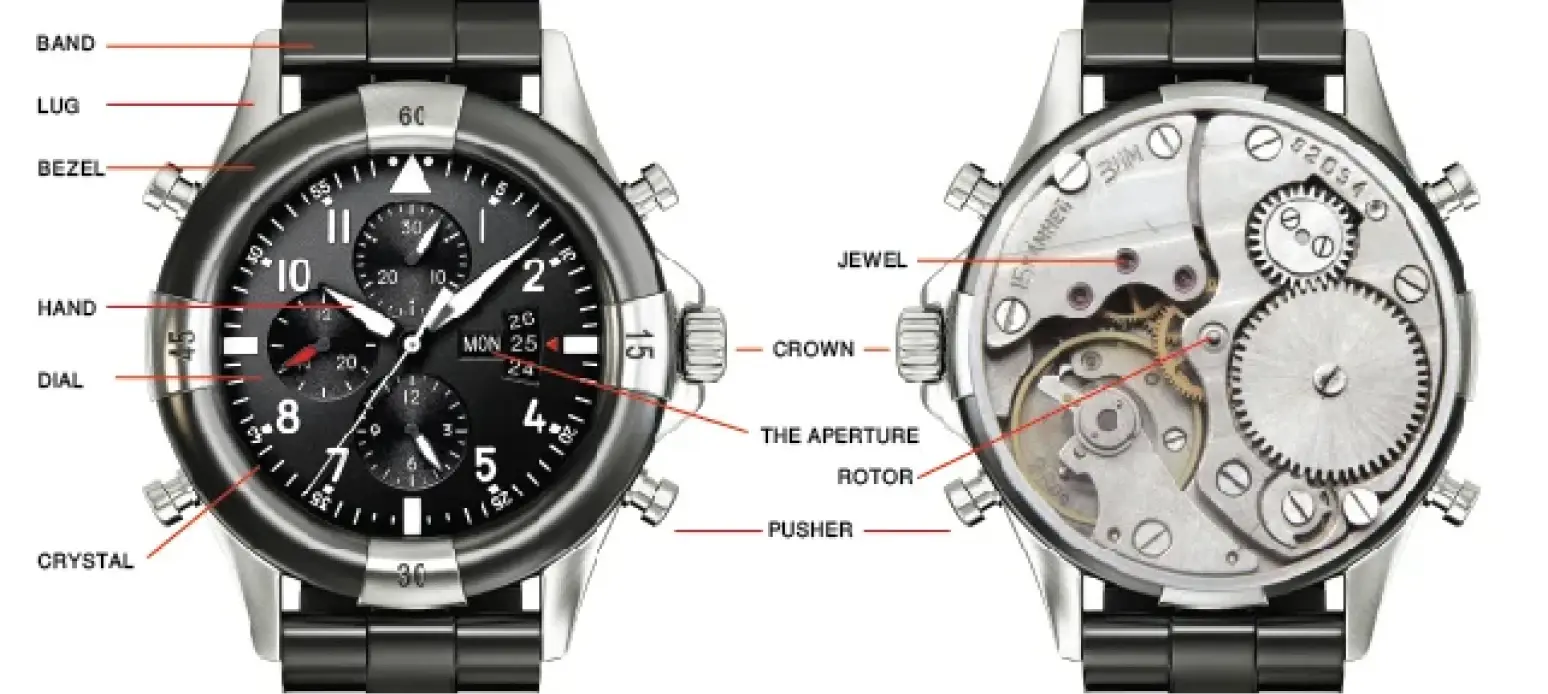
Aperture - A small window in the dial, which shows information such as the date or moon phase.
Bezel - The metal ring around the crystal on the top of the watch. It holds the glass or crystal in place.
Case - The container that protects the watch’s movement.
Crown - A button on the exterior of the watch case used for setting the time and calendar. On mechanical watches, it’s also used to wind the mainspring.
Crystal - Made of glass, synthetic Sapphire or plastic, the crystal is a transparent cover for the watch’s dial.
Dial - The plate that displays the hours, minutes and seconds.
Hand - Indicators that move around the dial, pointing to the hour, minute and second.
Jewel - Small Sapphires or rubies set into mechanical watch’s movements that reduce friction by acting as bearings for gears.
Lug - Also called “horns,” lugs are projections used for fastening the strap or bracelet to the case.
Movement - The engine of a mechanical watch that keeps time and powers the watch’s functions.
Pusher - Buttons on the outside of the case that control specific functions. They’re usually found on watches with a chronograph.
Rotor - Attached to the movement, the rotor revolves to wind the mainspring and store power in automatic timepieces.
Strap - A band of leather that straps the timepiece to the wrist. It must be non-metal to be called a strap. Metal versions are called “bracelets.”
Subdial - A small dial positioned inside the main dial that displays additional information.
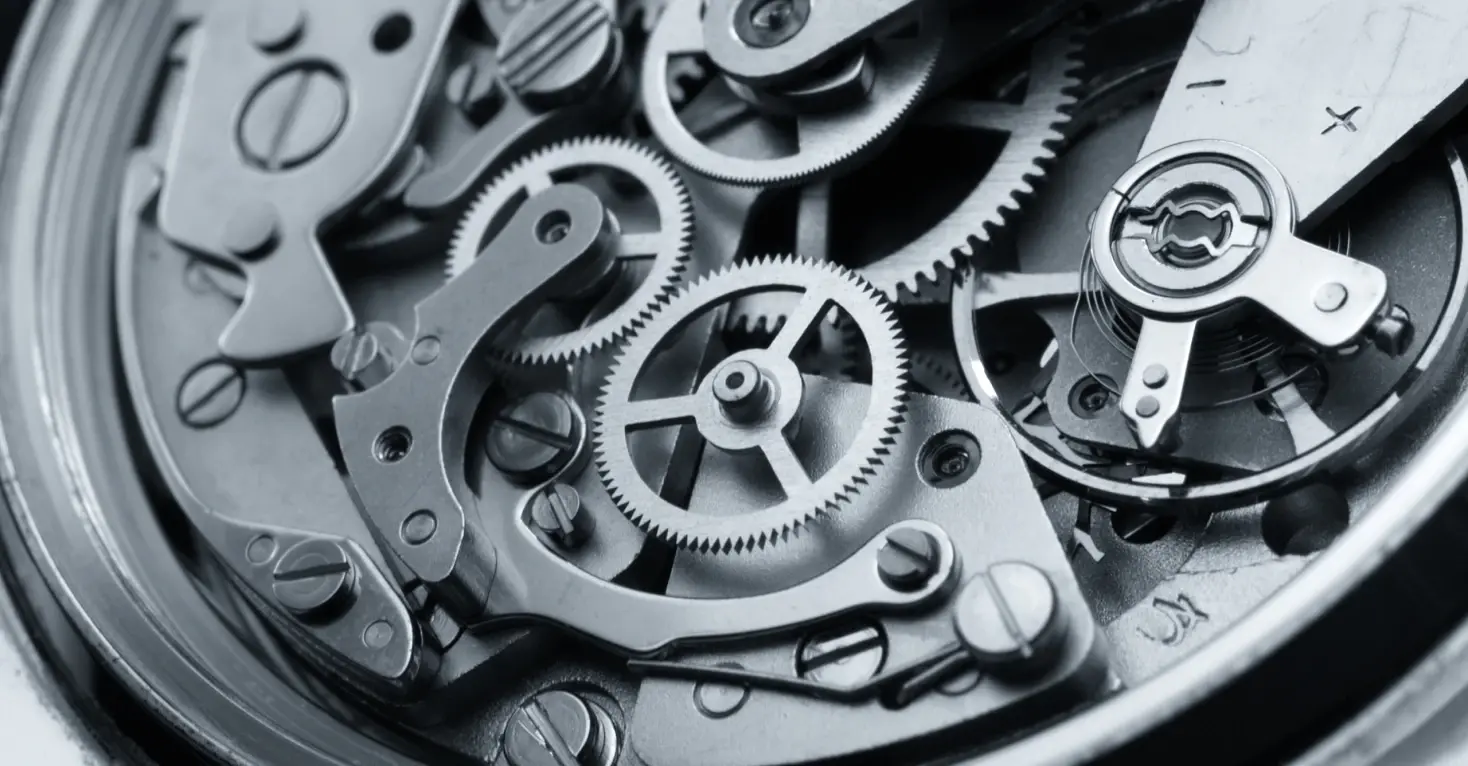
Also known as a “calibre,” a watch’s movement is its engine. It’s the powerhouse that moves the hands and makes the functions work. Without it, a watch would still be beautiful to look at, but it wouldn’t serve a practical purpose.
There are many different movements created by watch manufacturers using proprietary innovations and discoveries. Most of today’s movements fall into one of the following categories.
A relative newcomer, quartz movement burst onto the scene in the 1960s. Powered by batteries that send an electrical current to a quartz crystal, these watches are easy to care for, accurate and affordable.
The tell-tale mark of a quartz movement is the crisp ticking of the second hand. In most cases, the battery only needs to be replaced every 18 months to two years, making quartz movement undeniably low-maintenance.
The sister of mechanical movement, automatic movement is also designed around a mainspring. And like mechanical movement, automatic movement uses the ingenious designs of watchmakers through the centuries.
But automatic movement doesn’t require daily winding, and that’s why automatic watches are also called “self-winding.” Back in the 1920s, inventor John Harwood tackled the problem of watches becoming crippled by dust and muck stuck in their winding systems. In 1931, Rolex built on Harwood’s discoveries and created a movement with a perpetual rotor system, which used the arm’s natural movements to power the timepiece. To this day, all of Rolex’s automatic watches use the 1931 breakthrough technology.
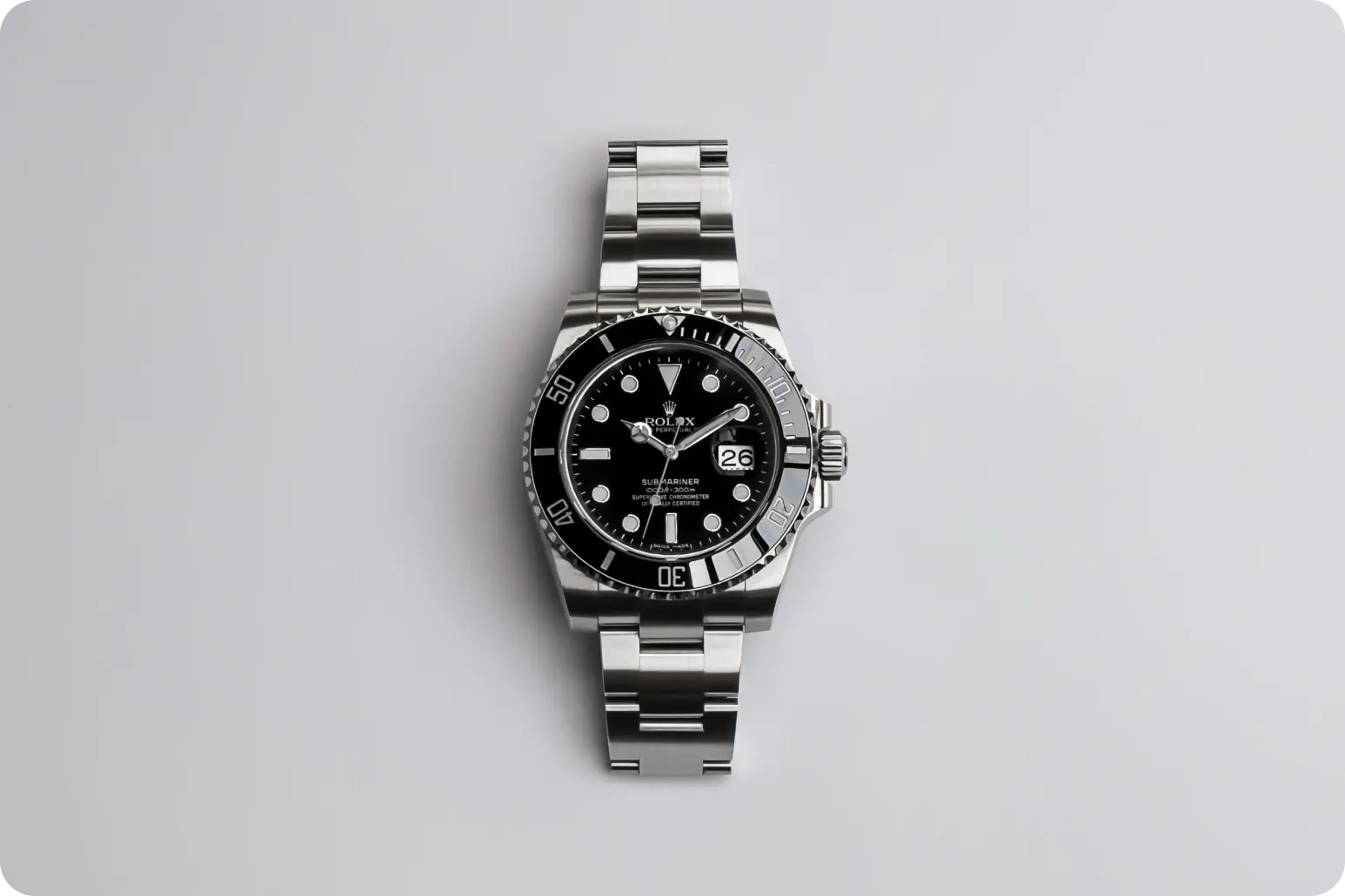
In layman’s terms, a chronograph is a stopwatch or timer, and a chronograph movement allows you to time something without interfering with the watch’s ability to deliver accurate time. Some chronographs can time up to 30 seconds while others can last for 12 hours.
Louis Moinet created the first chronograph in 1815 as a tool for working with astronomical equipment. A few years later, another Frenchman, Nicolas Mathieu Rieussec, brought the idea to the marketplace. Soon, King Louis XVIII commissioned a chronograph timepiece that would enable him to time horse races, one of his favourite pastimes.
It’s easy to confuse the terms “chronograph” and “chronometer.” For simplicity’s sake, a chronograph is a timepiece with a stopwatch or timer, and a chronometer is a precise watch.
Today, timeliness is important, but back in the 18th century, precision watches sometimes meant the difference between life and death for marine navigators. After the Sicily Naval disaster of 1707, the British government established the Longitude Act to offer a reward for the development of a reliable system for determining a ship’s longitude.
John Harrison, a Yorkshire watchmaker, designed a timepiece that could keep meticulous time even on a ship in the middle of the ocean. It remained accurate despite adverse temperatures, changes in air pressure, salt air corrosion, humidity and even the movements of a ship.
Today’s chronometer watches are based on Harrison’s design. They are subjected to rigorous testing by the Contrôle Officiel Suisse des Chronomètres (COSC) to earn chronometer certification.
A kinetic movement uses oscillating weights that are powered by the watch wearer’s movements. The movements create a magnetic charge within the watch, and that charge is turned into electricity.
Many newer kinetic watches can store energy for several months, keeping them accurate even when they’re not being worn.
John Harrison, a Yorkshire watchmaker, designed a timepiece that could keep meticulous time even on a ship in the middle of the ocean. It remained accurate despite adverse temperatures, changes in air pressure, salt air corrosion, humidity and even the movements of a ship.
Today’s chronometer watches are based on Harrison’s design. They are subjected to rigorous testing by the Contrôle Officiel Suisse des Chronomètres (COSC) to earn chronometer certification.
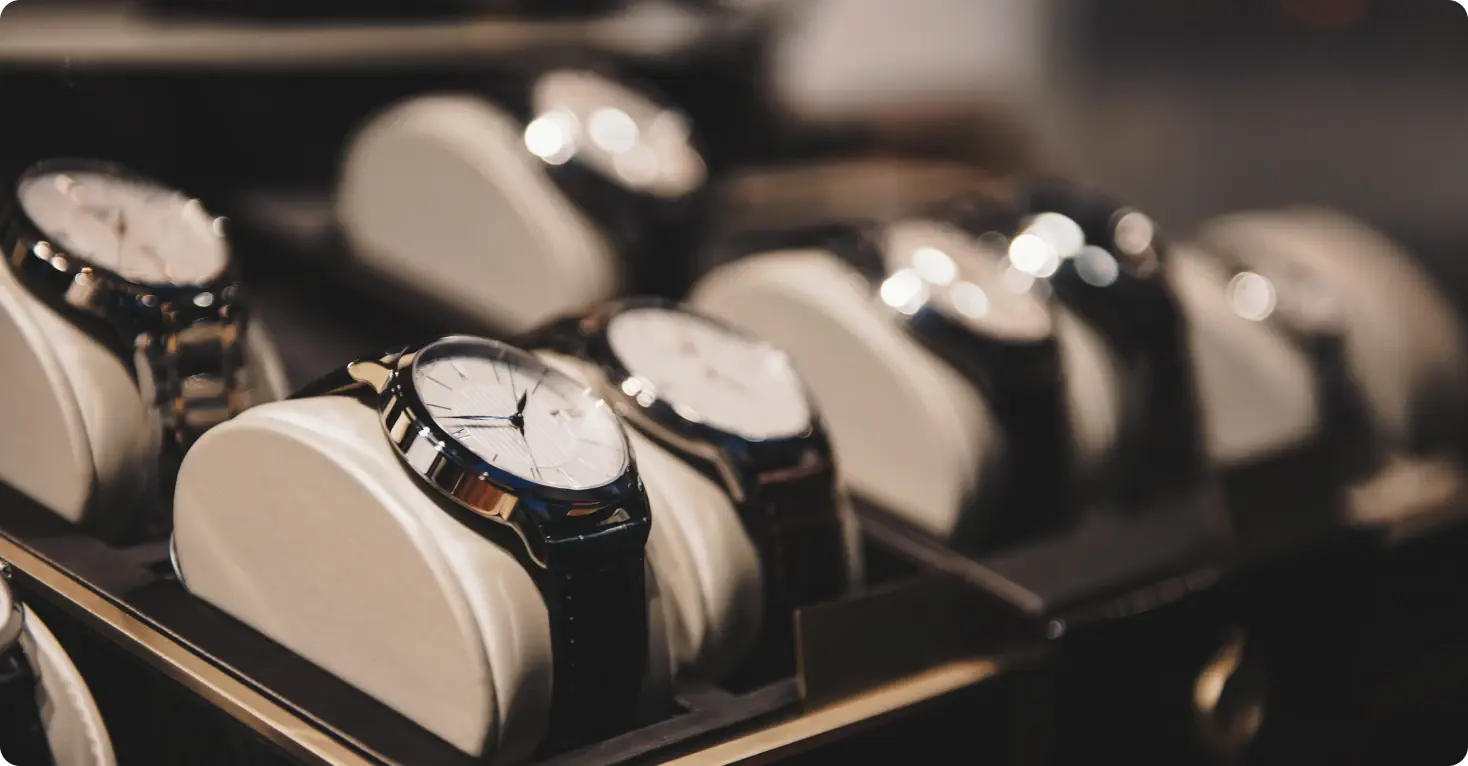
They’re fascinating, to be sure, but how do you go about buying a luxury watch? In this chapter, we’ll go through the process.
They’re fascinating, to be sure, but how do you go about buying a luxury watch? In this chapter, we’ll go through the process.
When you start exploring luxury watches, you may be surprised by the vast range in pricing. Let’s take a look at the standard price points and what you can expect in each field.
At this level, you’ll learn to love luxury watches for their features, design and elegance. What features can you expect to find in an entry level timepiece? Look for the following:
It seems obvious to look for solid metal construction, but you’d be surprised how many watch components are made of plastic. Examine the sides of bracelets to see if the links are hollow or solid. Hollow construction signals shortcuts in the manufacturing process.
The transparent cover over a watch’s face is called a crystal. For entry level luxury watches, you can expect to find crystals made of mineral glass and sapphire. If at all possible, choose a sapphire crystal because it’s more scratch resistant than glass.
The best movements in the entry level luxury watch market hail from Switzerland and Japan. At this price point, it’s challenging to find a mechanical movement, so keep your focus on quartz. Swiss movements usually come from ETA, and Japanese from Miyota, which is part of Citizen.
Some entry level watches are designed by actual watchmakers, and some are designed by fashion designers. Unfortunately, those intended for fashion’s sake often function poorly and may even have missing chronograph dials, too-short hands or inoperable measuring scales. Look for a watch designed by watchmakers.
Cheap watches often have single-locking mechanisms on their bracelets. Higher quality bracelets feature double or triple locking clasps to ensure that the watch will stay on your wrist even if it’s bumped or jostled.
Classic and formal watches aren’t expected to have dial illumination, but if you choose a watch with luminant on the dials, choose quality. Luminant from tritium gas tubes glow for about 25-30 years. Watches with LumiNova and SuperLumiNova are also good bets.
Once you experience the passion and taste of luxury watches, you raise your expectations and start to look at timepieces in this range. From mechanical movement to chronometer certification, the features in this price point are exciting.
Quartz movements are incredibly reliable, so why do people pay more for mechanical movement? Not only do mechanical watches run without a battery, but they also represent classical watchmaking and offer emotional value that battery-powered watches just can’t.
Not all mid-range (or even high-range) watches attain chronometer certification, but some do. COSC testing is rigorous. It’s specific to each movement and must be accurate within -4/+6 seconds per day.
Enjoy exploring all the gorgeous case finishes and polishes you’ll find at this price point. In the watch world, finish refers to the amount of parts-finishing that the movement receives. A hand-finished movement resembles artful jewellery. Look for Geneva waves, bevelling and black polishing (also called specular or mirror polishing) from luxury watches at the upper end of this price point.
Mid-range luxury watches are beautiful. You’ll find special touches like polished rotors, textured dials and machine engravings on the dial. This detailing, even if you can’t see it, vouches for the watch’s value and makes it more memorable to you.
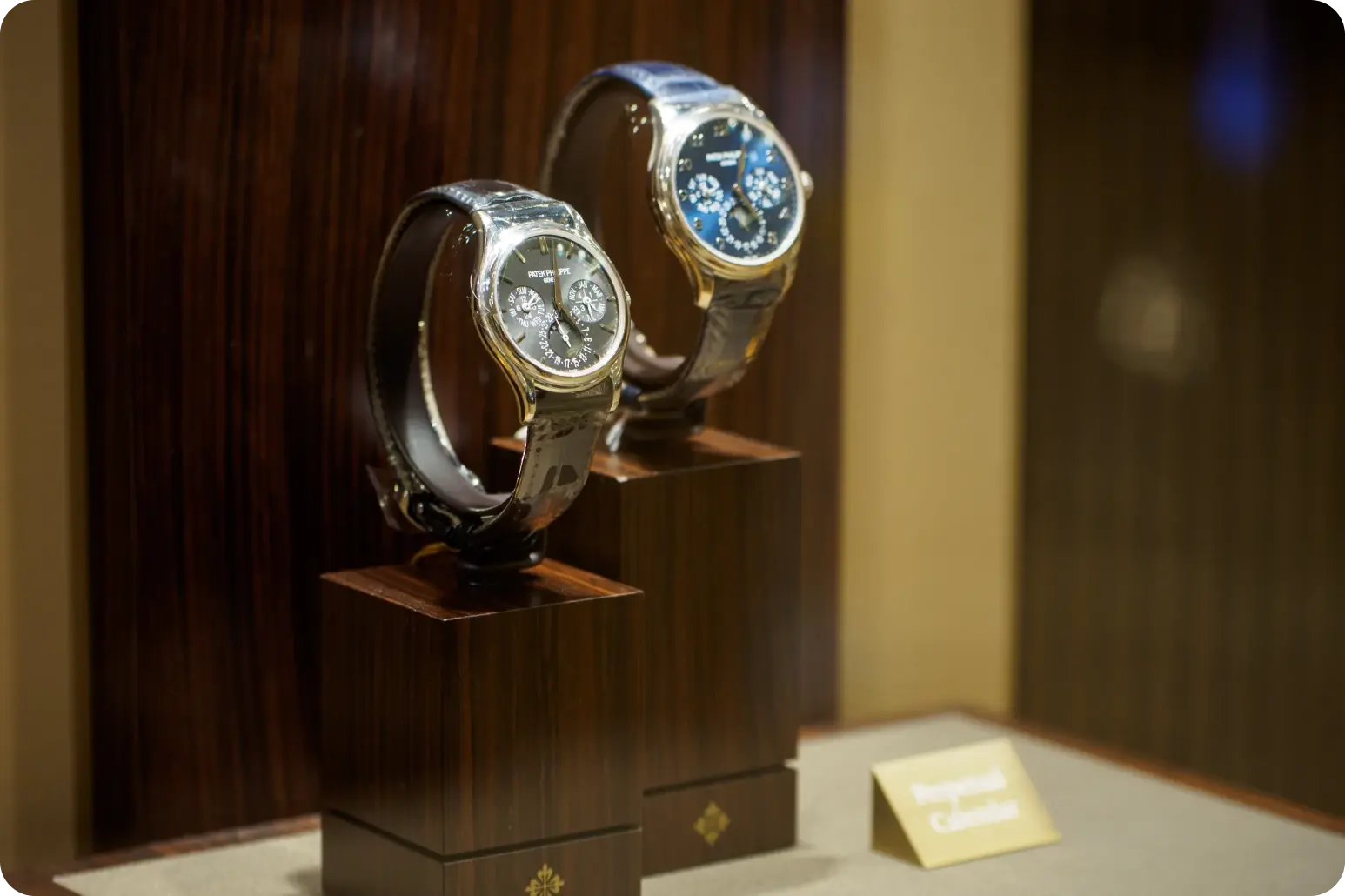
After years of appreciating luxury watches, buyers of high-end timepieces know what they’re looking for. And often, they’re looking for features such as the following:
Instead of titanium and stainless steel, you’ll see 18K gold and platinum at this price point. Investigate how much of the watch is constructed of precious metals. Some cases will be wholly made of precious metals, others just parts.
The two primary options for jewels are natural and manufactured. At this price point, look for natural. Although they don’t necessarily perform any better, there’s a romance to knowing your jewels were mined from the earth. Sapphires and diamonds are the most common jewels in luxury watches.
The highest-end watches are handmade by expert watchmakers, and the quality shows. It’s not uncommon for a watchmaker to toil for an entire year over a single high-end luxury watch. Each part must be fabricated, decorated, assembled and tested, and this process can take many months.
High-end luxury watches don’t just tell time. They may also include spectacular complications, each with complex movements to back up their functions. For example, some watches have perpetual calendars, sonneries, moon phases and even multiple time zones. Each of these complications adds to the exquisite beauty and function of high-end luxury watches.
The best luxury items are produced in limited quantities, and this is definitely true for timepieces. Not all high-end watches are made in limited batches, but many are. So ask how many models are made of the watches you’re interested in.
Unfortunately, the market is flooded with all manner of luxury watch fakes and reproductions. To make sure you’re getting what you pay for, buy your timepieces from a reputable watch dealer.
A long-established watchmaker will likely be around when you need service or repairs. You may also need to exchange parts in the future, so starting a long-term relationship can be incredibly helpful.
Q Report Certified Jewellers offer cover for your watch, so it can be insured from the moment you walk it out of the shop. If anything happens to your luxury watch, you can return to your watchmaker for repair or replacement.
Determining the authenticity of a luxury watch can be difficult, but it’s not impossible. The following clues can help.
Fake model numbers are common among phoney luxury watches, especially Rolexes. Familiarise yourself with the model numbers of watches you’re interested in, and always verify them.
Online databases allow you to research fake serial numbers. Many watchmakers and dealers have access to these databases and can verify numbers for you.
Luxury watchmakers are picky about their models’ colouring, so familiarise yourself with your favourite models, and don’t trust off-colour replicas.
Authentic models include information about the magnification of cyclops windows, so if the numbers appear too large or too small, you’re likely looking at a phoney.
Replicas and fakes often have a difficult time mimicking the real movements of high-end luxury watches. Incorrect movements can be a dead giveaway.
Since luxury watchmakers take such pride in their products, the boxes and papers should match the quality of the timepiece itself. Paperwork folders should be made of genuine leather, and the box’s stitching should be precisely regular.
Navigate your luxury watch shopping experience by learning to ask the right questions. Since watches are complex items that require a great deal of knowledge to understand, you’ll want to ask plenty of questions before any purchase. Be sure to ask the following.
Brand new luxury watch models generally command higher prices than those that have been out for a few years, but that’s not the only reason to ask this question. If a salesperson doesn’t know this necessary information, he or she is unlikely to know much else about the watch. The watch’s release date can also help you to know if there will be a sizeable pre-owned market for a particular model.
When you ask about a watch’s movement, don’t settle for general answers like “quartz” or “automatic.” Probe further to find out which manufacturer created the movement and seek details about how the watch is powered.
When you find a watch you like, it’s helpful to learn about feasible alternatives. You may end up preferring an alternative to the timepiece you’re initially interested in.
Some watches require more servicing than others, so it’s wise to decide upfront how much maintenance you’re willing to deal with. Watches are machines, and like all machines, they need to be serviced. Fortunately, watches are lower maintenance than cars, but they still need cleaning and oiling every few years to keep them in top condition.
It sounds like the most fundamental question of all, but it’s essential to learn how a watch works before you buy it. Many watches simply offer the time and date, but some have complications that feature chronographs, calendars, and so forth.
Precision, quality, workmanship, innovation, superior engineering. Each of these facets deserves a deep research dive, and watch collectors gain a great deal of satisfaction from learning about the intricacies of their timepieces.
The following websites and blogs can help you to learn everything you want to know about luxury watches
This robust online magazine features reviews, critiques and reports. It’s a favourite of watch collectors of all ages.
Check in with Haute Time for horology news, up-to-date information and the releases of the latest luxury timepieces.
With nearly two dozen new blog posts each week, you’ll never run out of research and reviews on this site.
In addition to reviews and blog posts, Monochrome offers historical data on a range of luxury timepieces.
With a variety of diverse contributing writers, this New York-based watch website includes reviews of both new and vintage pieces.
Based in the Netherlands, Fratello Watches covers luxury watch events, the timepiece industry and new releases.
Time and Tide connects Australian watch collectors with the latest news and watch reviews from around the world.
Founded by Su Jia Xian, who got his start as a watch journalist, SJX gives insights into the Asian watch market.
Jomashop has been in the luxury goods trade for many years and covers not just watches but also handbags, crystal and fine writing instruments.
For up-to-the-minute watch news and reviews, check out Watchuseek, one of the world’s most visited watch sites.

In this chapter, we’ll look at some of the top luxury watches on the market today. As you can see, understanding luxury watches takes some effort. It’s a whole world that may have been hidden to you until now.
The following watches are iconic. You’ll hear about them again and again on the blogs and websites listed above. In many cases, these watches are standards against which other watches are measured.
Each and every component in the highly complex Richard Mille RM11 is custom-made, and the machined sapphire crystal is printed on. Richard Mille compares his watches to Formula 1 cars, and the analogy seems spot on.
Introduced in 1997, the Patek Aquanaut is the sporty younger brother of the Patek Nautilus. Its rounded octagon case and “Tropical” strap took the luxury world by storm when they first appeared.
The Nautilus changed the face of watchmaking when it appeared on the market in 1976. Inspired by a ship’s portholes, this classic is a magnificent add to any luxury watch collection.
Audemars Piguet has a history of creating complicated pocket watches, and that history shines through in the Royal Oak. Considered to be the world’s first luxury sports watch, the Royal Oak has received exciting modern updates over the years. Its fantastic bones have remained the same, however: a self-winding chronograph with a vertical clutch and 40-hour power reserve.
With its skeletonised dial and titanium case, the Zenith Defy El Primero 21 echoes Zenith’s previous Defy collection, which ended in the 1990s. Today's collection has a different vibe. It's modernised, elegant and attention-getting.
At times, watch collectors have dealt with ten-year waiting lists for Rolex Daytona watches, and you’ll likely have to wait for this version as well. The ceramic bezel improves scratch resistance, and the quality of this timepiece is impeccable--well worth waiting for.
Rolex launched its first GMT models in 1954, and over the years, it has released various colour schemes. The most popular models have been the fizzy drinks combinations (bright red and blue for Pepsi, dark red and black for Coke, and brown and gold for root beer).
Known for making incremental improvements to their watches, Rolex has created the GMT Master II Batman, which is an update of a traditional fan-favourite. The company filed 10 patents related to its Chronometer-certified movement.
Back in 1953, Rolex produced the first wristwatch waterproof to 100 metres, the Submariner. It set the standard for diving watches. Today, the diving watch receives a superlative Chronometer rating. Recent models have been updated with large luminescent hour markers and a rotatable Cerachrom bezel, but it retains its iconic 1953 character.
Just as Rolex created a watch for divers, they also designed one specifically for air travellers. The Sky Dweller features a second time zone display on an off-centre disc. Its sophistication and rotatable Ring Command bezel make this watch a perfect match for frequent travellers.
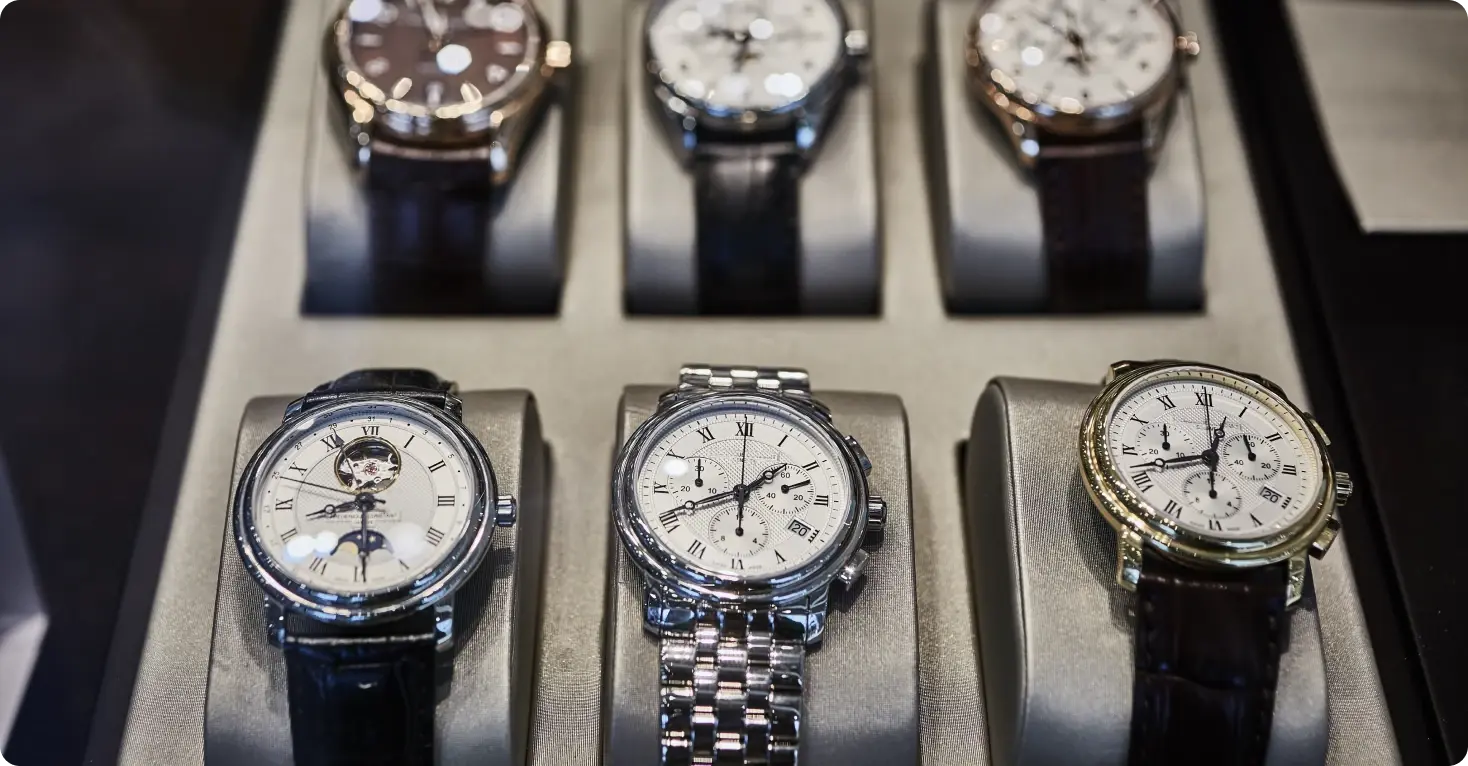
Classic vintage watches never go out of style, but navigating the vintage luxury watch market can be intimidating. As you embark on the journey, keep the following in mind.
With vintage timepieces, condition is the most significant factor when determining value. Watches that have been resurfaced or repainted are often worth far less than pieces in mint condition.
Look for watches with original bezels, hands and movements. Many collectors pay top dollar for original packaging, manuals and even receipts.
Keep in mind that men’s luxury watches have increased in size over the years. You may have a difficult time finding a vintage watch that lives up to today’s size standards.
Unfortunately, fake vintage watches have flooded the market. Hence, it’s critical that you seek the help of a reputable watch dealer if you want to buy an authentic vintage luxury watch.
The old adage “Buy the Seller” rings especially true when it comes to buying vintage watches. If a seller isn’t up front with you or seems unwilling to answer questions, move on. We suggest seeking the services of a Q Report certified jeweller or watchmaker.
Never purchase a vintage timepiece without seeing it in person. You’ll want to employ your detective skills to examine a watch’s authenticity, and it’s just not possible to do this online.
Also, avoid showing up at a vintage watch shop without a firm idea of what you’re looking for. Research your chosen model before you shop so you can recognise fonts and hand styles, compare colours, and look for other clues that designate authenticity.
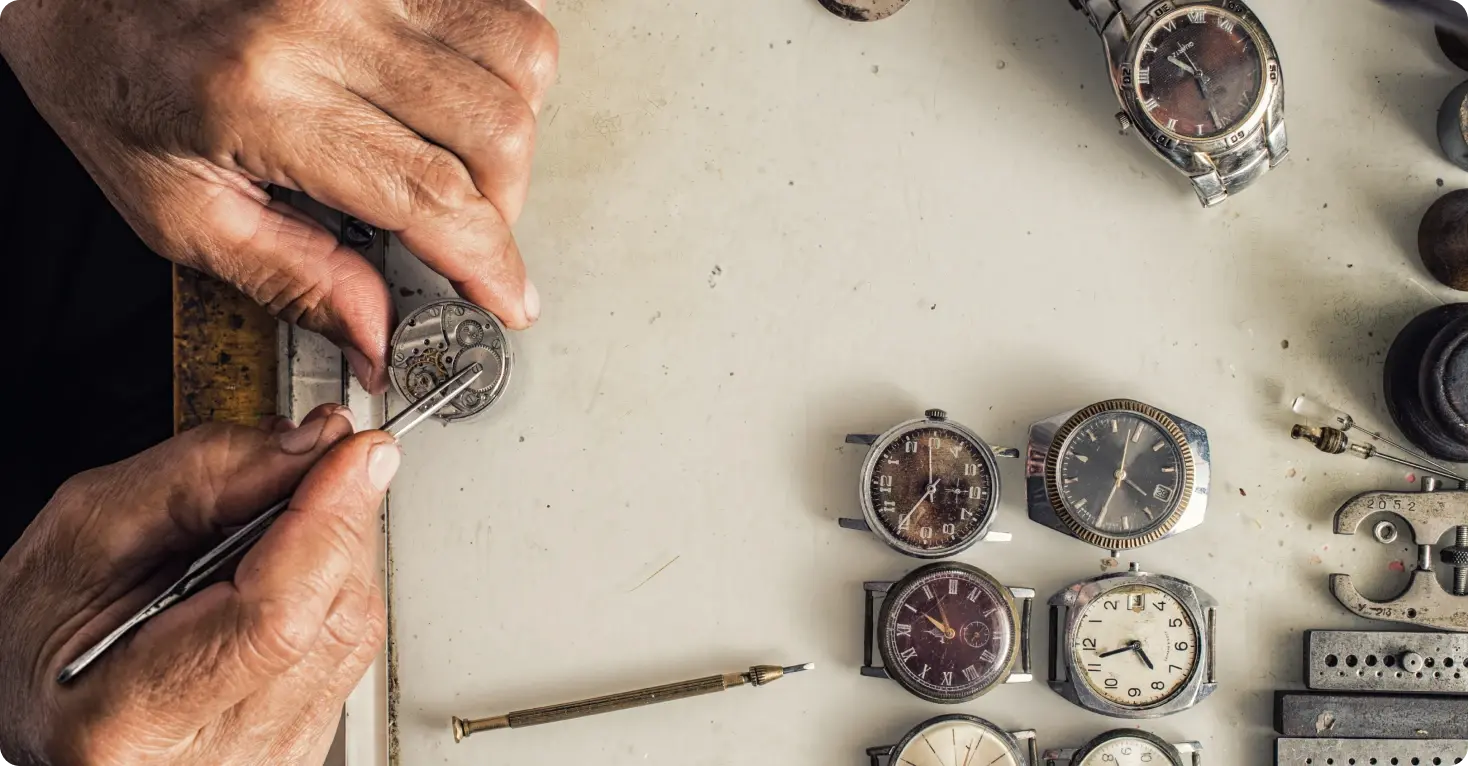
Luxury watches are high-ticket items, and as such, they deserve white glove treatment. In this chapter, we’ll learn about caring for your watch.
At times, you’ll need to take your timepiece to a watchmaker for servicing, but most of the time you can take care of maintenance at home. Here are a few tips to keep your watch running smoothly and looking new.
Wipe down the band and case with a soft cloth. If your watch is water resistant, soak it in water and mild soap to loosen dirt and prepare it for a good shine. A soak every few months should suffice.
Know and understand your watch’s water resistance. Most modern luxury watches are water resistant, but vintage watches tend to lose their waterproofness over time. So take care. Also, avoid splashing water on your watch’s leather straps.
Remove your watch when participating in activities that could scratch or damage the crystal.
When you’re not wearing your watch, store it in its box, which was designed to prevent scratches and dings. It will also keep the strap or bracelet in an optimal position.
Finally, get to know your watch well. Some require special care or maintenance, and you’ll learn this information by reading the manual and talking with your watchmaker.
Over time, too much sunlight can cause the dial to fade, and too much heat can shorten battery life.
Cleaning supplies and perfume can damage your watch’s leather, so avoid spraying them near your watch. If you perfume your wrist, make sure it dries before you put your watch on.
Proximity to magnets can interfere with your watch’s movement, so avoid placing your watch near speakers, microphones, refrigerators and electric motors. A watchmaker can correct magnetisation problems.
Complex mechanical systems need servicing regularly. If you want to keep your watch in tip-top shape, take it to your watchmaker every two to three years for cleaning, oiling and inspection.
When a watch is regularly serviced, it can continue to function as designed for many years, holding (or even increasing) its value and giving you years of pleasure.
Your luxury timepiece may be a tribute to your hard work, a treasured family heirloom, a fashion statement or a gift from a loved one. Whatever your watch means to you, protect it with insurance.
Our watch cover has an agreed-upon value, so you never run the risk of receiving a lower cost replacement. You can also return to your original watchmaker for repairs or replacement, ensuring high-quality service and selection.
With Q Report cover, your watch will be covered anywhere in the world. You can travel with it safely, knowing it’s protected wherever you go. Every 12 months, we offer free revaluation, so you always know that your luxury timepiece is fully protected.
That’s the Q Report difference. We love luxury watches as much as you do, and we’ve created watch insurance that will protect your investment while allowing you to wear your timepieces as often as you like.
Get an instant online quote today and discover the difference for yourself.